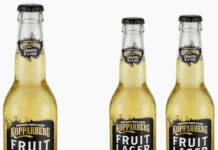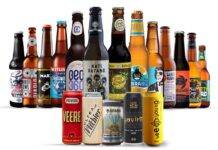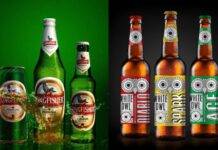The King of Beer is Here! It is a limitless world of beer. From classic lagers to bold IPAs to funky sour ales, just look at a dizzying number of drink options available at any given bar. Beer types spawn more sub-categories than drinkers know what to do with them.
Normally, draft beer menus at local watering holes offer a few standard brands to list beverages that seem to come out of nowhere. And each beer tastes more complex than the other. Knowing what certain styles of beer look and taste like will make the process of narrowing down a favorite much simpler.
The difference between types of beer majorly comes from the type of yeast used in the fermenting process. Depending on the fermenting procedure a beer will eventually qualify as an ale or lager. An ale is created through a top fermentation method. This is a process in which the yeast settles at the top of the beer and ferments at warmer temperatures.
On the contrary, the type of yeast used to make lager settles at the bottom of the beer. The fermenting process takes place under cooler temperatures and is much longer. Moreover, the yeast used in lagers has a lower tolerance for alcohol than the yeast used for ales.
Beers as such start out as an ale or a lager. Their specific styles and flavors continue to evolve from here. There are numerous types of beer under the broad ale category. These include Pale Ales, India Pale Ales (IPA), Stouts, Porters, and the Belgian and Wheat styles. Lagers encompass another range of styles. These include the Dark American Lagers, German Helles, and the Pale Pilsners. Here is how different types of beer styles are broken down.
- What is Pale Ale? Pale ales are normally hoppy. They carry a lower alcohol content in comparison to IPAs. Many types of pale ales, including English pale ale, blonde ale, American amber ale, and American pale ale, are malty, medium-bodied, and easy to drink.
- What is an IPA? IPAs or India Pale Ales encompass numerous styles of beer They get their characteristics largely from hops, herbal, citrus, and/or fruity flavors. IPAs can be bitter and contain higher levels of alcohol. The final product, however, depends upon the variety of hops used in the process. Quite a few IPAs taste like pure citrus. Others are bitter and strong. Some of the most prominent IPA styles of beer include British IPA, New England Style IPA, and West Coast IPA. They are commonly considered a beer drinker’s first introduction to the world of craft beer. However, it is suggested that you try out a variety of IPA styles before finally settling on a couple of favorites.
- What is a Stout Beer? Stout beer is a dark beer. The flavor of stouts, however, depends upon how they originate. Sweet stouts largely come from England and Ireland. They are well known for their low bitterness. Ireland’s Guinness is a popular brand producing some of the world’s most recognizable stout beer. Stouts according to BJCP (Beer Judge Certification Program) are a sweet, full-bodied, and slightly roasty ale that can suggest sweetened espresso or coffee-and-cream.This variety of dark beer gives the impression that it is tough to drink. Stouts carry sweetness from unfermented sugars that offset any bitterness. Stouts produced in the U.S. are typically dark-bodied. They combine creamy notes with the hoppy bitter flavor, commonly characterized by American beers. Stouts in America are usually strong. They are highly roasted, bitter, and hoppy as well. According to the BJCP they come with high malt flavors that give them the taste of dark chocolate or coffee.
- What is a Porter? Traditional porters trace back their roots to the United Kingdom. They are dark in color like stouts due to common ingredients like chocolate and/or other dark-roasted malts. However, Porters tend to taste less like coffee than stouts. They impart more of a chocolatey feel.
- What is Belgian Beer? The rich beer culture of Belgium has poured into the U.S. They give enthusiasts on this side of the Atlantic a deep appreciation for the wide variety of Belgian-style flavors. Spanning from dark ales, fruity beers, pale ales, and sour ales, bars and other establishments across the world usually define Belgian-style beers as carrying sweet, fruity, and spicy flavors with low bitterness, alongside high alcohol content. Some popular Belgian beers across the globe include Trappist ales. These are produced only at Trappist monasteries that brew their own beer. Trappist ales encompass beers like Belgian Dubbel. It is somewhat strong and complex. Belgian Tripel, on the other hand, is pale, dry, and spicy. Blond ales like Delirium Tremens further add a strong flavor profile to Belgian beers.
- What is Wheat Beer? This variety of beers relies on wheat for the malt ingredient. It gives the beverage a light color and alcohol level that makes it perfect for kicking back during the summer. It is ideally combined with fruit, like a slice of orange or lemon. Some wheat beers, with their funky and tangy flavors, fall under Belgian-style brews. Wheat beers made in the U.S. have a light flavor that recalls bread.
- What is Dark American Lagers? This is an American-style lager that has a golden, light appearance. It is unhazy in appearance with plenty of bubbles. Dark American Lagers tend to have a touch of hops and malt. It makes them exceptionally palatable to most tastes. However, all lagers are different. Many have a pleasant toasty along with a grainy flavor mixed with fruity elements.
- What are German Helles Lager? It is a traditional German pale lager beer variety chiefly produced in Munich, Southern Germany. The German word hell can be expressed as ‘light’, ‘bright’, or ‘pale’. Helles is light, crisp, and easy on the palate. The grains used in the brew are pilsner malt. They provide a light sweetness and cereal-like grain flavors to the beverage. Hops are used and provide some flavor and balance. However, they play a supporting role to the malt alongside adding hints of spices, herbs, and florals from the old-world European hop varietals to the brew. Munich Helles is a lager that was created at Munich’s Spaten brewery in 1895. It effectively competes against popular Pilsner-style beers. Nevertheless, it has notable differences from traditional Pilsner. This style with a creamy white head pours a clear, bright straw yellow to pale-golden color.
- What are Pale Pilsner Lagers? Pilsners originate from the Czech Republic. They broadly fall under the lager variety. With higher bitterness, Czech pilsners are a little darker in color. On the flip side, German pilsners give off a pale gold color and crisp flavor. Normally pilsners are a type of pale lager.But not all lagers are pilsners. It is a type of beer conditioned at low temperatures. While lagers can be yellow pale, amber, or dark, Pilsners are a pale lager and the most widely consumed and commercially available style of beer.
- What is Sour Beer? Over the last few years Sour beer has shot up in popularity in the United States. It has become an enticing beverage to people looking to branch out their beer palates. Ideal for those wanting to try something new, some sour beers are highly tart and can take on many forms like fruity Flanders ale, lemony Berliner Weisser beer, and Belgian-style Lambic beer. With the addition of fruits like cherry, peach, or raspberry, sour beers marry sweet and sour to complete beer flavors.
Difference between Lager & Pilsner Beer
The difference between pilsner and lager is that Pilsner actually is a type of lager. It is named after the Czech city Plzen where it originated. Another notable difference between pilsner and lager is that pilsners tend to have more hop-forward flavours. And they use a different type of yeast during the fermentation process. Pilsners ultimately are just more spicier, and hoppy lagers.
Difference between Ales & Lager
The basic difference between ales and lager is how these two major beer types are fermented. Ales are fermented at warm temperatures of 60˚–70˚F, and lagers are fermented at cold temperatures ranging between 35˚–50˚F. While ales use the top-fermenting yeast, the lagers utilize the bottom-fermenting yeast during the brewing process. Moreover, ales generally ferment and age in a relatively short span of 3-5 weeks’ time. On the contrary, lagers take much longer to ferment because of the cold condition required for the process. Lagers take up to 6 to 8 weeks for processing.
However, all beer before the birth of the Pilsner style in the 1800s were ales since yeast was not known as an ingredient and the cold fermentation process eventually would have been difficult. Nevertheless, both ales and lagers can nowadays be produced with relative ease. The current craft beer market ales since they are typically more common and as the ale yeast can produce beer in as little as 7 days’ time.
The process of producing ales is far more convenient for small breweries that may not have the fermenter space to produce lagers on a regular basis. Nonetheless, the advancement of technology has played an important role in the advancement of producing both, ales and lagers.
The ability to see yeast strains and differentiate under a microscope and the advent of refrigeration in the 1800s altered the entire course of beer production. the late 19th century and most of the 20th saw the dramatic rise of lager. Moreover, the lower alcohol content and mellow taste of the brew led to the takeover of pilsner-style beers.
Ale has thankfully made a resurgence in the last 40 years. There were just 55 breweries operating in the United States in 1974, and they were all mass producing the flavorless, watered-down lager version of the brew. No true craft beer lover now would be caught drinking that.
There are more than 6,000 breweries now, creating ales and lagers, and a combination of the two. They have in fact brought beauty and art to the beer brewing process.








